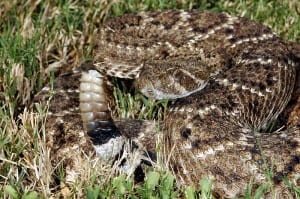How the rattlesnake’s tail came to Camden Town
By Celine West, on 20 December 2012
Once upon a time there was a rattlesnake, he lived in the high desert of North Western New Mexico. No doubt conceived in love, he was born live, not out of an egg like most other snakes. He grew up big and strong, lithe and supple, with dark diamond-shaped patterns along his back. When he was growing up, he grew larger than his skin so he slipped out if it, shedding the thin scaly coat on the sandy ground and not looking back.
He spent his days sliding swiftly across the sandy terrain, hunting small mammals and striped lizards, darting away from potential dangers such as those large-bodied creatures that lolloped around. When he did come face to face with trouble he lifted his tail end so that it shivered and shook and made a fearsome rattle. As hot day passed into cool dark night and back again, he lived out his life in the eternal present.
There came one day into those parts a young man, not that our rattlesnake ever saw him, but there he was. None of the animals took any note of where he had come from or where he was going. He rolled up his sleeves despite the sun so hot it would burn his pale skin pink, he wiped his forehead with a handkerchief his aunt Isabella had given him the previous Christmas. He took slow, purposeful steps in handstitched nubuck boots.
He had a leather bag containing glass jars in a variety of sizes, empty matchboxes, tweezers, magnifying glasses: collecting paraphernalia. He was looking for what he could find, and what he found were animals he had never seen before except in the books he had read back home. He picked up a scorpion carcass and held it more delicately than he would hold his new born son’s hand three years hence. Beneath a wiry shrub he found the remains of a snake, saw from the final inches of its tail that it was a rattlesnake, Crotalus atrox, crotalus from the Greek meaning castanets. He used his knife to detach the tail end, held it between thumb and two fingers and shook it gently. It did indeed rattle. He shook it again, the sound like beans in a jar, like shingle with the sea passing over. He put it in his bag.
There were not the legislations, the prohibitions, that there are now about the collection or movement of animals, animal parts, from country to country. The young man returned to London and gave the contents of his collecting bag to the university where he had studied*. The specimens were part of a collection, a multitude of animals and animal parts used to teach the students about their kingdom. The collection evolved into the Grant Museum of Zoology.
Time passed, years blurred into decades and everyone who had had anything to do with the rattle snake tail when it first arrived here was gone. Times changed, the museum opened to the public, even on Saturdays, and did funky modern things like film nights; they even let people touch things. They even let the sticky-fingered-masses known as children touch things.
On a bright and freezing Wednesday the other week I went to a tiny vibrant infant school down the road from Camden Town tube station. Two dozen seven year-olds sat in a circle on the carpet in their classroom. The children wriggled and fidgeted, as small bundles of energy tend to do, yet they sat for an hour as around the circle a series of museum animals, animal parts, passed between their hands. Our excellent outreach person had come to visit and brought a suitcase of things with her, such as a long-eared bat, a mole skeleton, a grass snake’s vertebrae strung together in one long length, a starfish, a bumble bee.
And a rattlesnake’s rattle, in a clear plastic box the size of a seven year-old’s hand, not to be removed from the box, but picked up and shaken gently. The children said “wow”, and “is it a caterpillar?” and “that’s amazing”. They wanted to tell us everything they knew about animals, and ask a hundred questions like, “does the bat have long ears to cover his eyes while he sleeps?” and “what’s the difference between an alligator and a crocodile?” and “how did you put the pin in the bumble bee?”
They touched, they learned, they enjoyed. A worthy afterlife for the rattlesnake’s tail?
*in this case, Imperial, but our lucky rattlesnake tail eventually made its way here so that’s all that matters.
 Close
Close


